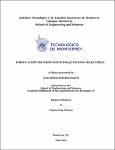| dc.contributor.advisor | Gómez Espinosa, Alfonso | |
| dc.contributor.author | Rodríguez Suárez, Jesús Braian | |
| dc.creator | GOMEZ ESPINOSA, ALFONSO; 57957 | |
| dc.date.accessioned | 2022-09-02T01:32:27Z | |
| dc.date.available | 2022-09-02T01:32:27Z | |
| dc.date.created | 2021-06 | |
| dc.date.issued | 2021-06 | |
| dc.identifier.citation | Rodríguez Suárez, J. B. (2021). Robotic-computer vision system for 3D welding trajectories (Tesis Maestría) Instituto Tecnológico y de Estudios Superiores de Monterrey. Recuperado de: https://hdl.handle.net/11285/648782 | es_MX |
| dc.identifier.uri | https://hdl.handle.net/11285/648782 | |
| dc.description | https://orcid.org/0000-0001-5657-380X | es_MX |
| dc.description.abstract | The necessity for intelligent welding robots that meet the demand in the real industrial production, according to the objectives of Industry 4.0, has been supported thanks to the rapid development of computer vision and the use of new technologies. In order to improve the efficiency in weld location for industrial robots, this work focuses on trajectory extraction based on color features identification over three-dimensional surfaces acquired with a depth-RGB sensor. The system is planned to be used with a low-cost Intel RealSense D435 sensor for the reconstruction of 3D models based on stereo vision and the built-in color sensor to quickly identify the objective trajectory, since the parts to be welded are previously marked with different colors, indicating the locations of the welding trajectories to be followed. This work focuses on the use of point cloud and a color data to obtain a three-dimensional model of the workpiece with which the points of the target trajectory are segmented by color thresholds in the RGB and the HSV color space, finally a spline cubic interpolation algorithm is implemented to obtain a smooth trajectory. Experimental results show that the RMSE error for V-type butt-joint path extraction is under 1.1 mm and below 0.6 mm for a straight butt joint, showing a suitable system for welding bead of various shapes and materials. It is important to note that to demonstrate its application in a robotic environment, the expected results will be presented in virtual environments created on the Robot Operating System (ROS) software. | es_MX |
| dc.format.medium | Texto | es_MX |
| dc.language.iso | eng | es_MX |
| dc.publisher | Instituto Tecnológico y de Estudios Superiores de Monterrey | es_MX |
| dc.relation.isFormatOf | draft | es_MX |
| dc.relation.isreferencedby | REPOSITORIO NACIONAL CONACYT | |
| dc.rights | openAccess | es_MX |
| dc.rights.uri | http://creativecommons.org/licenses/by-nc-nd/4.0 | es_MX |
| dc.subject.classification | INGENIERÍA Y TECNOLOGÍA::CIENCIAS TECNOLÓGICAS::TECNOLOGÍA DE LA INSTRUMENTACIÓN::TECNOLOGÍA DE LA AUTOMATIZACIÓN | es_MX |
| dc.subject.lcsh | Technology | es_MX |
| dc.title | Robotic-computer vision system for 3D welding trajectories | es_MX |
| dc.type | Tesis de Maestría / master Thesis | es_MX |
| dc.contributor.department | Escuela de Ingeniería y Ciencias | es_MX |
| dc.contributor.committeemember | Escobedo Cabello, Jesús Arturo | |
| dc.contributor.committeemember | Swenson Durie, Rick Leigh | |
| dc.contributor.mentor | Cuan Urquizo, Enrique | |
| dc.identifier.orcid | https://orcid.org/0000-0002-7411-791X | es_MX |
| dc.subject.keyword | Path model | es_MX |
| dc.subject.keyword | 3D reconstruction | es_MX |
| dc.subject.keyword | Seam Extraction | es_MX |
| dc.subject.keyword | Color segmentation | es_MX |
| dc.subject.keyword | RGB-D | es_MX |
| dc.contributor.institution | Campus Monterrey | es_MX |
| dc.contributor.cataloger | emipsanchez | es_MX |
| dc.description.degree | Maestría en Ciencias de la Ingeniería | es_MX |
| dc.identifier.cvu | 652670 | es_MX |
| dc.date.accepted | 2021-05 | |
| dc.audience.educationlevel | Investigadores/Researchers | es_MX |
| dc.identificator | 7||33||3311||331101 | es_MX |



